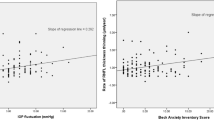Abstract
Depression and sexual dysfunction have been related to side effects of topical beta-blockers. We performed a preliminary study in order to determine any difference between a non selective beta-blocker (timolol) and a selective beta-blocker (betaxolol) regarding CNS side effects. Eight glaucomatous patients chronically treated with timolol 0.5%/12h, suffering from depression diagnosed through DMS-III-R criteria, were included in the study. During the six-month follow up, depression was quantified through the Beck and Zung-Conde scales every two months. In a double blind cross-over study with control group, the patients under timolol treatment presented higher depression values measured through the Beck and the ZungConde scales (p<0.001 vs control). These results suggest that betaxolol could be less of a depressioninducer than timolol in predisposed patients.
Similar content being viewed by others
References
Hinshelwood RD. Hallucinations and propanolol. Br Med J 1969; 1: 445.
Waal HJ. Propanolol induced Depression. Br Med J 1967; 2:50.
Miller RA. Propanolol and impotence. Ann Int Med 1976; 85: 682–3.
Middlemiss DN. Direct evidence for an interaction of betaadrenergic blockers with the 5-HT receptor. Nature 1977; 267: 289–90.
Koella WP. CNS related side-effects of beta-blockers with special reference to mechanism of action. Eur J Clin Pharmacol 1985; 28 (sppl): 55–63.
Westerlund A. Central Nervous System side effects with hydrophilic and lypophilic beta-blockers. Eur J Clin Pharmacol 1985; 28 (suppl): 73–6.
Shanks RG. Clinical Pharmacology of beta-adrenoreceptor blocking drugs. In: Morselli PL, Cavero I, Kilborn JR et al., editors. Betaxolol and other beta 1-adrenoceptor antagonist. New York: Raven Press, 1983: 73–88.
Ferrandes B, Durand A, Paisse J et al. Pharmacokinetics and metabolism of betaxolol in various animal species and man. In: Morselli PL, Cavero I, Kilborn JR et al., editors. Betaxolol and other beta 1-adrenoceptor antagonist. New York: Raven Press, 1983: 51–64.
Fraunfelder FT. Sexual dysfunction secondary to topical ophthalmic timolol. JAMA 1985; 253: 3092–3093.
Davidorf FH. Did I tell you the story about Jim, the neurologist? Contemp Ophth Forum 1987; 5: 4.
Van Buskirk EM. Adverse reactions from Timolol administration. Ophthalmology 1980; 87: 447–50.
Lynch MG, Whitson JT, Brown RH. Topical beta-blocker therapy and Central Nervous System side effects: a preliminary study comparing betaxolol and timolol. Arch Ophthalmol 1988; 106: 908–11.
Cohn JB. A comparative study of the central nervous system effects of betaxolol vs timolol. Arch Ophthalmol 1989; 107: 633–4.
Conde V, Useros E. El inventario para la medida de la depresión de Beck. Rev Psiquiat Psicol Med Eur Am Lat 1974; 12: 153–67.
Conde V, Useros E. Adaptation castellana de la escala de evaluation conductual para la depresión de Beck. Rev Psiquiat Psicol Med Eur Am Lat 1975; 12: 217–36.
Conde V, Escriba JA, Izquierdo JA. Estudio crítico de la escala autoaplicada para la medida cuantitativa de la depresión de Zung. Rev Clin Esp 1970; 117: 71–8.
Conde V, Escriba JA, Izquierdo JA. La escala autoaplicada para la depresión de Zung (SDS) en pacientes ambulatorios. Med Clin Esp 1970; 54: 305–18.
Diagnostic and statistical manual of mental disorders, 3rd ed, revised, 1987. The American Psychiatric Association.
Tocco DJ, Duncan AF. Physiological disposition and metabolism of timolol in man and laboratory animals. Drug Metab Dispos 1975; 3: 361–70.
Constain DW, Green AR. Beta adrenoreceptor antagonist inhibit the behavioral responses on rats to increased brain 5-hydroxytryptamine. Br J Pharmacol 1978; 64: 193–200.
Alvan G, Calissendorff B, Scideman P et al. Absorption of ocular Timolol. Clin Pharm 1980; 5: 95–100.
Phan TM, Nguyen KV. Ophthalmic beta-blockers: relative ocular penetration, systemic absorption and binding affinities to the beta-1 and beta-2 receptors. Invest Ophthalmol Vis Sic 1987; 28 (suppl): 285.
Orlando RG. Clinical depression associated with betaxolol. Am J Ophthalmol 1986; 102: 175.
Petrie WM, Maffucci RJ. Propanolol and depression. Am J Psych 1982; 139: 92–4.
Author information
Authors and Affiliations
Rights and permissions
About this article
Cite this article
Duch, S., Duch, C., Pastó, L. et al. Changes in depressive status associated with topical Beta-blockers. Int Ophthalmol 16, 331–335 (1992). https://doi.org/10.1007/BF00917986
Issue Date:
DOI: https://doi.org/10.1007/BF00917986




